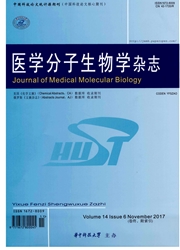

 中文摘要:
中文摘要:
目的探讨绿茶对苯并芘(benzo[a]pyrene,B(a)P)诱导的DNA损伤的保护作用。方法①采用稳定转染抑癌基因p53-GFP质粒的p53-/-MEF细胞(p53-GFP细胞)分为DMSO对照组,B(a)P处理组,B(a)P和绿茶共处理组检测各组细胞中GFP荧光的激活情况;②将WI-38细胞分为DMSO对照组,DOX阳性对照组,B(a)P处理组,B(a)P和绿茶共处理组,用Western印迹检测不同处理组WI-38细胞中p-p53,γ-H2Ax,PARP和Caspase-3蛋白表达的改变。结果荧光结果显示,10μmol/L的B(a)P能够明显激活p53-GFP荧光,而绿茶和B(a)P共处理后荧光激活被抑制;用Western印迹检测发现,与DMSO对照组相比,B(a)P处理的wI-38细胞中P-p53和γ-H2AX蛋白表达水平升高,PARP和Caspase-3蛋白的切割增强,而绿茶和B(a)P共处理的WI-38细胞中p-p53和γ-H2AX蛋白表达水平较B(a)P处理组明显降低,PARP和Caspase-3蛋白的切割也明显减弱。结论本研究采用稳定转染p53-GFP质粒的p53-/-MEF细胞初步观察到绿茶可能对苯并芘诱导的DNA损伤具有保护作用。在WI-38细胞中的进一步研究证明,绿茶与B(a)P共处理能降低WI-38中p-p53和1-H2AX的表达水平,并且减弱PARP和Caspase-3蛋白的切割。提示,绿茶对苯并芘致WI-38细胞DNA损伤具有保护作用,其机制可能与抑制DNA损伤和凋亡通路有关。
 英文摘要:
英文摘要:
Objective To explore the protective effect of Chinese green tea on DNA damage in- duced by benzo [ a] pyrene (B (a) P) . Methods ① The p53 -/-MEF cells were in vitro cul- tured and transfected with p53-GFP to obtain p53-GFP cells. Then the transfected cells were divided into DMSO control group, B (a) P treatment group and B (a) P + Chinese green tea treatment group. GFP fluorescence was detected by fluorescence microscopy in each group. ② The WI-38 cells were divided into DMSO control group, DOX positive control group, B (a) P treatment group and B (a) P + Chinese green tea treatment group. The expression levels of p-p53, γ-H2AX, PARP and caspase-3 were detected by Western blotting in each group. Results Fluorescence microscopy showed that10 μmol/L B (a) P could significantly activate the fluorescence in p53-GFP cells, which was suppressed after treatment with Chinese green tea. Western blotting revealed that the ex- pression levels of p-p53 and γ-H2AX were significantly increased in B (a) P-treated WI-38 cells when compared with the DMSO control group, and B (a) P could increase the cleaved levels of PARP and caspase-3. Chinese green tea could reduce the expression levels of p-p53 and γ-H2AXand attenuate the increased cleaved levels of PARP and caspase-3. Conclusion Chinese green tea can protect against B (a) P-induced DNA damage in WI-38 cells by inhibiting the pathways associ- ated with DNA damage and apoptosis.
 同期刊论文项目
同期刊论文项目
 同项目期刊论文
同项目期刊论文
 期刊信息
期刊信息
